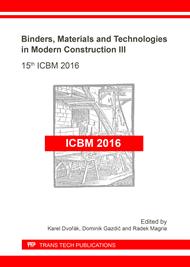p.29
p.35
p.40
p.45
p.51
p.56
p.63
p.71
p.76
Influence of Pozzolanic Additive on Pore Size Distribution of Lime Mortar
Abstract:
Pozzolanic additives are widely applied as components of cementitious composites as well as mortars based on white lime. They are generally recognized as components improving the durability of resulting material – concrete or mortar. The mechanism responsible for this favorable effect lies in physical and chemical modification of initial binding system. The present paper deals with influence of a pozzolanic additive – ceramic dust (CD) – on pore system of lime – based mortar. The CD was characterized by means of elementary and phase analysis. The range of mortars of varying CD/lime ratio was prepared; their pore size distribution, strength and rate of liquid water and water vapor were determined. The presence of CD caused change in the pore size distribution while the total porosity did not changed significantly. The volume of large pores was reduced and amount of fine pores was increased as consequence of growing CD content. It had positive effect on rate of liquid water transport. Diffusion resistance factor was influenced by the presence of CD towards the lower values; in opposite to the liquid sorptivity the diffusion resistance was controlled by the total porosity. The strength was improved by addition of pozzolanic additive as could be expected. It is in accordance with the reduced volume of capillary pores but obviously the presence of pozzolanic additive in lime converts the binding system to hydraulic and thus the effect of CD on strength cannot be explained just by its influence on pore size distribution.
Info:
Periodical:
Pages:
51-55
Citation:
Online since:
October 2017
Authors:
Price:
Сopyright:
© 2017 Trans Tech Publications Ltd. All Rights Reserved
Share:
Citation:


